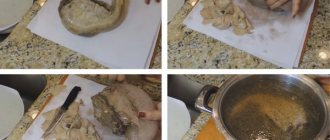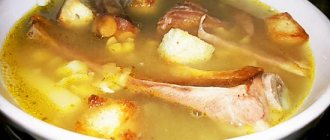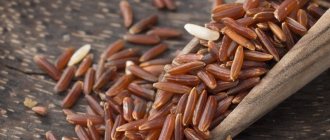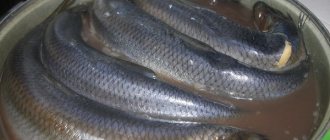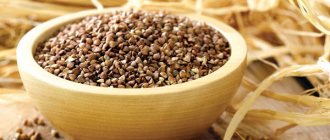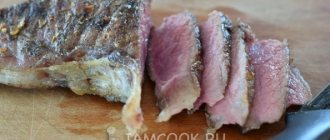How to cook beef tongue correctly and how much – cooking features
There are many recipes on how to properly cook tongue, the main thing that unites them is the standard form of preparation and a number of technological features of preparation. So, before starting the cooking process, the tongue must be thoroughly washed, carefully brushed, and the remaining fat cut off from the bottom. Remove sublingual muscle tissue and bone, if any.
After this, the product must be soaked in a salty solution for 30 minutes to cleanse the meat of any remaining blood and mucus. Then rinse under running water again and put in a pan for further cooking. It is also important to know how long to cook beef tongue. Here the time depends on the weight of the product and pre-treatment. A well-washed and cleaned offal weighing up to a kilogram will cook faster - from 2 to 3 hours.
How to cook beef tongue in a saucepan in water
Recipe for boiled beef tongue weighing 1 kg 500 g.
The prepared meat is placed in a saucepan, filled with cold water and boiled over medium heat until foam appears. After removing it, continue cooking for another 1.5 hours. Then drain the broth and pour in clean water. Bring it to a boil, lower the tongue and continue the cooking process. Here, the amount of liquid in which the tongue will be boiled is of no small importance; it should be neither too little nor too much. Just enough to completely cover the meat, allowing for evaporation.
Ingredients:
- for soaking - 2 tbsp. spoons of salt per 2 liters of water;
- for taste - 1 carrot, 1 onion;
- for aroma - 2 bay leaves, allspice 8 peas;
- add salt half an hour before cooking.
To enhance the smell, you can use ginger, parsley, celery, and garlic. Cook the tongue over low heat for 4 hours. After the time has passed, the finished tongue is transferred to a bowl with cold water, the shell is removed, and sliced.
When cooking the tongue, you need to take into account its increase in volume, so for convenience it is better to take a deep pan with a wide bottom.
Tongue in a slow cooker according to a classic recipe
Often, to save time and speed up the process of preparing a delicious dish, program-controlled kitchen electrical appliances are used. Tongue cooked in a slow cooker turns out just as tasty and soft as on the stove.
After washing the offal under running water, it is placed in the bowl of an electric saucepan, along with the peeled vegetables, everything is filled with cold water and closed with a lid. Using the “quenching” button, you set the time range, usually 3 hours. The “start” command is given.
Ingredients:
- beef tongue – 900g;
- bulb;
- carrot;
- garlic – 2 cloves;
- bay leaf and other spices to taste.
Depending on the weight of the tongue, the cooking time can increase to half an hour. Spices and salt are added approximately 15 minutes before the end of cooking. Upon completion of the thermal process, the product is removed, cooled for 3 minutes in cold water, then gently peeled while slightly hot. Before serving, the tongue is cut into pieces. For garnish use mashed potatoes and green peas.
Steamed beef tongue
Simple and effortless steaming of tongue is very popular not only among professional chefs, but also among young housewives. The product takes about an hour to prepare. Cooking a dish in a double boiler begins with preparing the necessary products.
Recipe Ingredients:
- beef tongue – 700g;
- lemon – 1 piece;
- garlic – 2 cloves;
- hard cheese;
- spices, salt.
Before starting the process, the tongue is thoroughly washed and cleaned of dirt. Then it is cut into small portions, which are sprinkled with spices, salt, chopped garlic, and sprinkled with lemon juice. The pieces are wrapped in foil and placed on a special rack, which is inserted into the multicooker pan. Here, it is important to know that spices scattered on foil enhance the taste and aroma of meat.
By adding water to level 8 for 30 minutes, the product is subjected to heat treatment. After time has elapsed, the finished pieces of tongue are carefully removed and peeled using a knife. To add a piquant taste, the pieces are sprinkled with grated cheese, wrapped in foil and steamed for 5 minutes. The tongue, retaining maximum nutrients, turns out juicy and aromatic.
In a pressure cooker
Preparation of the product using a pressure cooker is significantly shortened. Only 40-50 minutes will be enough. For cooking, you can use the same products as in the recipe for cooking in a slow cooker. Only the cooking method is different.
The tongue is also used for preparing salads, aspic, and snacks.
Here are some simple and delicious recipes:
- Combine 300 grams of boiled tongue (cut into strips), 250 grams of fried champignons (thin slices), 50 grams of prunes and chopped hazelnuts, a small onion (finely chopped). Season everything with pepper, salt and light mayonnaise to taste.
- For jellied beef tongue, use 1 boiled beef tongue, cut into strips, boiled carrots, chopped into rings, 2-3 boiled eggs, cut into slices. If desired, you can add canned peas and garnish with sprigs of herbs. Gelatin is added to the broth, since in this case there are no bones that affect the degree of solidification of the broth. Spices and salt are used to taste.
- For a tasty, satisfying hot dish you will need 600 grams of boiled tongue, 200 grams of champignons and cheese, a couple of tomatoes, a stack of cream, a tablespoon of flour and sour cream, a small onion, spices and salt. Mushrooms and onions are finely chopped and fried until tender, so that the liquid evaporates as much as possible. Gradually add mixed cream with sour cream and flour, seasoned with spices. The mass should warm up slightly and become thick. Spread parchment or a silicone mat on a baking sheet, lay out slices of boiled tongue (1-1.5 cm thick), put sour cream and mushroom mixture on each, cover with a tomato ring and cover with cheese. At 200 degrees. bake for a third of an hour.
If you decide to cook beef tongue at home, but don’t know how to do it and what to cook with it, then this article will help you. We will share secrets and tell you how the best chefs in the world advise how to cook tongue correctly.
Boiled beef tongue is a tasty and dietary dish
Properly cooked tongue is a truly versatile product. It can act as an independent dish, but chefs do not miss the opportunity to make many tasty and nutritious dishes from it. Now we will tell you how, according to experts, beef tongue is cooked and what dishes can be prepared from it.
Experienced cooks recommend soaking the beef tongue first, and only then start peeling the skin. Cleaning the tongue is quite simple: as soon as the meat has softened after soaking, you need to scrape the surface with a knife to remove coarse fibers. Finally, the offal is washed under running water.
Cooking beef tongue largely depends on a properly selected pan: during the cooking process, the meat increases significantly in volume, so it is necessary to take dishes with large sides.
You can prepare this delicious dish either on a regular stove or using modern kitchen appliances. In this case, it is important to know how long the housewife should cook the tongue until it is ready:
- In a pressure cooker, the cooked offal will be ready in an hour.
- In the slow cooker, set it to the “Stew” mode for six hours.
- You can use a double boiler and cook the beef tongue for about three hours.
Delicious recipes with boiled beef tongue
Exquisite gourmet meat is used not only as a separate dish for appetizers, but for preparing various aspic dishes.
A simple salad with boiled beef tongue can become a “signature” treat for any housewife.
To prepare you will need:
- boiled beef tongue – 500g;
- boiled potatoes – 300g;
- pickled cucumbers – 2 pcs;
- one apple;
- hard cheese – 50g.
Beef tongue, potatoes, cucumbers must be cut into thin slices. Grate the apple on a coarse grater. Place the prepared foods in a salad bowl. Then add 2 chopped celery stalks, 2 tbsp. spoons of olive oil, 1 tsp. honey, white pepper and salt to taste. Mix everything well, sprinkle grated cheese on top of the salad. Garnish with finely chopped onion.
Beef tongue stew
With ready-boiled tongue, you can quickly prepare a delicious stew, stewed in the oven. To do this, you need to cut 600g of boiled offal into strips, one carrot, 4 pcs. potatoes, onion. All ingredients are placed in layers in a pot, filled with broth in which the tongue was cooked and placed in the oven for 30 minutes. The finished dish is poured into plates and sprinkled with herbs.
Beef tongue appetizer
This light dish is ideal for both holiday and everyday menus.
To prepare you will need:
- boiled beef tongue – 600g;
- mushrooms – 100g;
- sour cream – 1 tbsp. spoon;
- prunes - 2 berries;
- two walnuts;
- onions – 1 pc.
Remove the skin from the boiled tongue and leave it to cool in the broth. Chop the onion, fry in olive oil until transparent, then add boiled mushrooms to the frying, season with sour cream and simmer a little.
Grind prunes with walnuts and mix with mushrooms. Then add black pepper and salt to taste. The tongue is cut into small portions and placed on a plate. The mushroom mixture is laid out on pieces of meat and decorated with parsley or dill. The snack can be eaten both warm and cold.
Delicious tongue pate
Boiled, peeled tongue weighing 700 g is finely crumbled and placed in a mixer cup. Finely chopped eggs (3 pieces), butter (70g), two sprigs of parsley, black pepper, and salt are also placed there. The ingredients are whipped into a homogeneous mass, turning into puree. The finished mixture is transferred to a sealed container and placed in the cold to harden. The pate has a delicate consistency and is served in special molds with green peas or marjoram leaves.
Recipes with boiled beef tongue
Baked beef tongue
Ingredients for preparing beef tongue Beef
tongue – 700-800 grams, Sour cream – 4 tablespoons, Mustard sauce or soft mustard – 2 tablespoons, Onions – 3 small heads, Carrots – 1 large or 2 medium-sized, Bay leaf, salt, pepper and other seasonings - to taste.
When cooking, grated carrots, pepper and bay leaf are added to the beef tongue. Remove the film from the beef tongue. Cut the tongue into pieces, mix with finely chopped onion, add seasonings, place in layers in a baking dish (can be made from foil on a baking sheet), brush each layer with sour cream mixed with mustard sauce, and place in an oven preheated to 200 °C. Bake for 10-15 minutes.
Salad with boiled beef tongue
Ingredients for salad with beef tongue
Beef tongue - 100-150 grams Potatoes - 2 small potatoes Chicken eggs - 2 pieces Pickled cucumbers - 6 small Pickled champignons - 100 grams Mayonnaise or sour cream - 2 tablespoons Dill - 20 grams
Preparing a salad with boiled beef tongue
Boil and peel beef tongue, potatoes (in their jackets) and eggs. Cut tongue, potatoes, pickled cucumbers and eggs into thin shavings, cubes, and champignons into slices. Season with mayonnaise or sour cream, stir, and top with chopped dill.
Language "for the New Year"
Ingredients
Beef tongue - half a kilo Fresh champignons - half a kilo Cream 10% - 200 ml Garlic - 2 cloves Onion - 1 head Parsley - 3 tablespoons Carrots - 1 small carrot Sunflower oil - 3 tablespoons Salt - to taste
How to make beef tongue salad
Boil the beef tongue for 3 hours, then add carrots, onions, bay leaves and salt to the pan, cook for another half hour. Cool the beef tongue under cold water, remove the skin and cut into cubes. Wash the champignons, dry and cut. Peel the onion and finely chop. Fry the onion in sunflower oil, add the champignons and fry for 15 minutes over medium heat without a lid. Then pour the cream into the frying pan and simmer, stirring, for 20 minutes. Mix mushrooms with beef tongue, sprinkle with chopped parsley. Serve the salad warm.
How to salt your tongue before cooking
Ingredients
Beef tongue - 1 medium-sized, weighing 1 kilogram (so that it marinates well) Coarse sea salt - 2 tablespoons Mustard - 1 tablespoon Ground black pepper - 1 teaspoon
How to cook salted tongue
1. Wash, peel, dry and rub the beef tongue with mustard , sprinkle with pepper and salt. 2. Place the offal in a saucepan, cover and leave for 2 hours at room temperature, shaking halfway through. 3. Place the tongue in the refrigerator for 1 day. 4. Rinse your tongue, add fresh water, and lightly add salt. 5. Put the pan on the fire, cook after boiling for 2 hours, skimming off the foam with a slotted spoon. 6. Cool the tongue, hold it over ice water, and peel off the skin. Store the tongue in the broth and serve warm.
Cooking beef tongue
When cooking, grated carrots, pepper and bay leaf are added to the beef tongue. Remove the skin from the beef tongue. Cut the tongue into pieces, mix with finely chopped onion, add seasonings, place in layers in a baking dish (can be made from foil on a baking sheet), brush each layer with sour cream mixed with mustard sauce, and place in an oven preheated to 200 degrees. Bake for 10-15 minutes.
Every housewife tries to diversify the menu for her family, surprise guests with an original dish, and show off her cooking skills. The recipe for boiled beef tongue is often used in the kitchens of professional chefs, and is also accessible to novice housewives. A well-prepared product will make it possible to make the simplest dish refined and tasty.
Little secrets and tricks when cooking
Cooking beef tongue is not at all difficult. If desired, it is available to absolutely every home cook. Using the advice of professionals, you can learn how to cook tender, melt-in-your-mouth meat with minimal time.
- It is advisable to cook fresh beef tongue immediately so as not to lose its usefulness and taste.
- Rushing and lack of pre-processing will make the meat tasteless and tough.
- To make the tongue soft and tender, and the broth rich and tasty, it is recommended to add salt at the end of cooking.
- The delicacy product will turn out more juicy if it is immersed immediately in boiling water or, after peeling, placed in broth for 10 minutes.
- The degree of readiness of the offal is determined with a knife or fork. A properly welded tongue is easily pierced.
- The tongue should only be cooked over low heat to make it soft.
- It is necessary to monitor the broth in the slow cooker every 40 minutes. If it evaporates too much, add water.
- The cooked product for slicing is best stored in the refrigerator, wrapped in foil.
List of recipes
Beef tongue has a high protein content and a small amount of fat. It contains completely no carbohydrates. The tongue contains a lot of zinc and lecithin, which are beneficial for the nervous and cardiovascular systems. However, to preserve all the nutritional properties, it is important to follow the tongue preparation technology.
Beef tongue can be boiled in a saucepan or pressure cooker, baked in the oven, marinated, fried and stewed. To keep the offal tender, it is better to salt it in its ready-made form. How to calculate the time and how long to cook the tongue? Depending on the size of the product, its preparation time can range from 2 to 4 hours. However, boiled offal is not always used as an independent dish. You can prepare a variety of salads and snacks from the tongue. How long to prepare tongue salad depends on the recipe you choose. Usually 20-30 minutes is enough.
Quick cooking
Boiled offal takes a long time to prepare, but there is a way to reduce the time without losing the valuable properties of the finished dish. The secret is to use a pressure cooker. The device does not require your constant participation and at the same time allows you to prepare a dish quickly and tasty. How long does it take to cook a product in a pressure cooker? It will take no more than 40 minutes.
To cook in a pressure cooker you should use:
- Beef tongue – 0.5 kg.
- Water.
- Bay leaf.
- Pepper.
- Salt.
Method of preparing the product in a pressure cooker:
- Rinse the offal and peel it with a knife, and then place it on the bottom of the pressure cooker.
- Pour in water so that it covers the offal by 1 cm.
- Turn on high heat and wait until it boils.
- Then reduce the heat, add salt and spices.
- Cook for 35 minutes.
- Place the finished tongue under cold water and remove the film from it.
- Let cool and then cut into pieces.
Boiled offal can be used as an ingredient in various salads. It will give them nutritional value and unique taste.
How to cook boiled beef tongue according to recipes for various dishes
The general principles of boiling offal apply to most recipes. But different cooking technologies have their own nuances.
How to properly cook beef tongue for slicing
For salads and appetizers, only soft, uncooked meat of a young animal without fat and ligaments is suitable.
Ingredients:
- kilogram of offal;
- two large salad onions;
- large carrot;
- five peas of different peppers, bay leaves, salt.
Cooking method:
- Boil clean meat in the skin for 10 minutes, then change the water and cook for another 20 minutes. The water should be at least 12 centimeters above the edges of the tongue.
- Add spices, as well as whole onions and carrots without peel.
- Simmer over low heat for two hours. Add a large spoonful of salt seven minutes before the end of the process.
After cooking, soak the tongue in ice water and remove the skin.
We use boiled beef tongue for the children's table
According to this recipe, tongue can be given to even the smallest children as complementary food. And for an adult menu, the resulting meat puree can be baked as a soufflé.
Ingredients:
- 300 grams of boiled tongue;
- ten broccoli florets;
- two carrots.
Cooking method:
- Cut the offal into pieces and add a little salt.
- Boil peeled and sliced vegetables. Strain the broth.
- Place pieces of meat and vegetables in a blender bowl, pour half a cup of broth into it and puree.
This puree is offered to children as a separate dish or added to soups. It is also suitable for feeding elderly and weakened people after a long illness.
How to cook beef tongue deliciously in a slow cooker
Modern technology will speed up the process and keep labor costs to a minimum.
Ingredients:
- 700 grams of tongue;
- salt;
- three peas of different peppers, the same amount of bay leaves;
- carrot.
Cooking method:
- Place the thoroughly cleaned tongue in a bowl and fill it with water so that it completely covers the meat.
- Add seasonings, root vegetables chopped into large pieces and onions cut into rugs.
- In the “Cooking” mode, cook for 2 hours with the lid on. Add salt before completing the process.
The tongue turns out soft and tender, but you must not forget about the skin. It will quickly come off if you keep the hot product in ice water for a quarter of an hour.
Salad with beef tongue, mushrooms and cherry tomatoes
Recipe for preparing a delicious salad for a festive table. The main ingredients of the dish are boiled tongue, several types of mushrooms, cherry tomatoes and aromatic herbs. Arugula in salad is used not only for decoration, but also to add a spicy nutty-mustard taste.
To prepare the salad, you will need the following ingredients:
- Beef tongue – 0.5 kg.
- Champignons – 300 g.
- Oyster mushrooms – 0.4 kg.
- Shiitake – 0.4 kg.
- Cherry tomatoes – 0.2 kg.
- Onion – 2 pcs.
- Eggs – 4 pcs.
- Pickled cucumbers – 0.2 kg.
- Arugula – 0.1 kg.
- Mayonnaise.
- Olive oil.
- Salt.
- Ground black pepper.
Cooking method:
- Wash the champignons and oyster mushrooms and cut into pieces.
- Boil the shiitake in a saucepan until half cooked.
- Fry all 3 types of mushrooms in a frying pan with heated olive oil. Sprinkle them with salt and pepper.
- Boil beef tongue in a separate pan.
- Cut the boiled beef tongue into strips and mix with mushrooms.
- Add pickled cucumbers cut into slices, onion half rings and arugula leaves.
- Salt the salad and season with mayonnaise.
- Garnish the dish with halved eggs and cherry tomatoes.
Beef tongue goes well with mushrooms; various varieties can be used to prepare salads and main courses. But to make it tasty, you must first fry the mushrooms until golden brown.
How and with what to serve?
Various hot or cold dishes are often prepared from boiled offal. The tongue can also act as an independent snack. The hot offal can be served with a side dish of vegetables. The easiest way to serve beef tongue is to use it for cold slicing along with sausages, smoked and dried meats.
If the offal will be served as a separate dish, then a sauce must be prepared for serving. For example, you can make a dressing from apples, sour cream or mushrooms. To prepare apple sauce, you will need a couple of apples, a small piece of butter, half an onion and 150 milliliters of low-fat cream.
Jellied
Jellied is a dish consisting of broth and pieces of tongue. Aspic is usually prepared on holidays, since the process takes a lot of time. How long does it take to cook the aspic? Including setting time, the recipe requires up to 2 hours to prepare.
Ingredients:
- By-product – 1.2 kg.
- Bulb.
- Carrot.
- Parsley root.
- Parsnip root.
- Egg – 1 pc.
- Gelatin – 1 pack.
- Parsley for decoration.
- Salt.
- Spices.
Prepare the dish according to the following instructions:
- Rinse the beef tongue and place it in a pan with water, put it on the stove.
- Bring to a boil, constantly skimming off the foam.
- Then add the onion, carrots, salt, spices and cook for another 15 minutes.
- After this, remove the bay leaf from the broth.
- Cook on low heat for 2 hours.
- Then you can remove the pan from the stove, rinse the offal under cold water and remove the film from it.
- Cut the beef tongue into small slices.
- Remove carrots from the broth and cut into slices. They will be needed to decorate the aspic.
- Next you need to strain the broth.
- Salt and sprinkle with pepper.
- Stir gelatin in a glass of broth and pour into the pan where the aspic was prepared.
- Pour 3-4 mm of broth into the prepared plates and let it harden.
- Lay out pieces of tongue and carrots, and pour the aspic from the pan on top.
- Place the aspic in a cool place to harden, preferably overnight.
You can serve the aspic with horseradish or mustard, and use mashed potatoes as a side dish.
Tongue baked with mushrooms “under a fur coat”
The tongue can be baked in the oven and get a delicious dish for a holiday or family dinner. The recipe for baking tongue in the oven with vegetables and cheese is often called “under a fur coat”, due to the appearance of the crust on the finished dish.
The recipe for baking offal in the oven requires the following ingredients:
- Beef tongue – 0.5 kg.
- Champignons – 0.2 kg.
- Cheese – 0.2 kg.
- Tomato – 2 pcs.
- Cream – 50 ml.
- Bulb.
- Flour.
- Vegetable oil.
- Salt.
- Spices.
Step-by-step cooking recipe:
- Finely chop the mushrooms and onions and fry them in a frying pan.
- In a separate container, mix flour with cream, salt and spices.
- Pour the sauce into a frying pan and heat until a thick consistency forms.
- First boil the tongue in a saucepan, and then cut it into pieces 1-1.5 cm thick.
- Place pieces of tongue on a baking sheet, top with mushroom mixture, slices of tomato and cheese.
- Bake in the oven for 15-20 minutes.
It is recommended to serve the offal baked in the oven hot. You can decorate the dish with herbs. If desired, the recipe can be varied by adding bell peppers or eggplants. When baked in the oven, these vegetables add a delicate taste and subtle aroma to the finished dish.
How to cook beef and pork tongue: favorite recipes
The tongue can be cut lengthwise into thin slices and served with horseradish or mustard - this is an excellent Russian appetizer with vodka.
Tongue salads satisfy hunger and are very tasty if you combine meat with potatoes, avocado, pickles, mushrooms, cheese, green peas, eggs, carrots, garlic, herbs and mayonnaise. By taking any meat salad recipe and replacing the meat with tongue, you will get a very original and completely new tasting dish.
Very popular, baked in the oven with vegetables, mushrooms and cheese, and jellied meat and tongue aspic can be served on a festive table. The tongue can be fried, breaded, stewed with vegetables, pickled, made into meat rolls, casseroles, pies and homemade sausage. If you don’t have time to fuss over the stove, cook the simplest dinner option - tongue with pasta, beans, potatoes or rice.
The taste of this delicious offal can be varied with various spices - thyme, basil and Italian herbs.
And for dessert, a little trick on how to make your tongue even more tender and tastier. After boiling and removing the skin, put it back into the broth, to which spices and salt have already been added, cook for another 30 minutes and enjoy the aromatic and melt-in-your-mouth meat. It's very nice to be a gourmet!
The tongue can rightfully be considered a delicacy. It is tasty, tender and nutritious. Most often, beef and veal tongue is used in culinary recipes, and less often - pork tongue. Before cooking, it is recommended to soak the tongue in cold water, then boil it with salt and spices for several hours. As soon as the tongue becomes soft, transfer it to cold water, allow to cool and remove the skin. Then proceed according to the recipe. The tongue can be cut into thin slices and used for aspic. You can prepare any meat salad by replacing the meat with pieces of tongue.
There are 81 recipes in the “Recipes from the tongue” section
Pickled tongue
Another way to prepare offal is pickling. The use of seasonings and hot sauces allows you to get a savory snack for the holiday table.
Ingredients:
- By-product – 0.7 kg.
- Bell pepper – 0.3 kg.
- Garlic – 3 cloves.
- Dill.
- Olive oil.
- Soy sauce.
- Sugar.
- Vinegar.
Step-by-step recipe for marinating tongue:
- Boil the offal in a saucepan or pressure cooker. Remove the film from it.
- Wash the bell peppers and bake them whole in the oven.
- Place the hot vegetable in a plastic bag to steam. This will help remove the film from it. You will also need to remove the seeds from the inside of the pepper.
- Grind the offal and pepper into pieces, chop the dill, crush the garlic.
- Place all ingredients in a jar.
- Mix soy sauce, sugar, olive oil and vinegar.
- Pour the resulting mixture into the contents of the jar.
- Place in the refrigerator for a day.
Fried tongue in breadcrumbs
This recipe will help you prepare a delicious main dish or a delicious hot appetizer. Even picky gourmets will like the crispy crust.
It’s hard to even call this luxurious luxury offal an offal. Such an expressive taste, delicate texture (of a properly prepared tongue) leaves few people indifferent. Although some argue that it is difficult to spoil the tongue, unfortunately, more than once I had to try something dry and tough, with a dull taste, even under a generous layer of jellied meat...
So, so that the result is always pleasing:
1)
Pre-soak your tongue in a saline solution as described below. You can select spices and herbs to suit your taste. It is better to season the tongue by soaking it, then the aroma of spices and herbs will penetrate deeper.
2)
Never let the water boil when boiling! This will make the tongue hard and the broth cloudy.
3)
Let the tongue cook longer; if you are not sure of readiness, cook for another 15 minutes. The main signs of readiness: the tongue can be easily pierced with a knife and the skin of the tongue comes off easily.
4)
Clean your tongue right away while it is still hot. Then, when it cools down, you will need to tear off the skin with your “teeth”.
That's probably all. As you can see, everything is very simple.
When I cook a tongue, I always leave the thinner, more beautiful part for serving as slices with different sauces. And from the thick part I prepare salads (a salad recipe will be coming soon), and I definitely cook a rich soup from tongue trimmings with horseradish, using a decoction of the tongue (a recipe will also be available). My friends always look forward to this soup very much. And I’ll tell you that he is like that, that there is something to look forward to ;-).
Ingredients
- 1 beef tongue
For brine for each liter of water:
- 45 grams salt
- Zest of 1/2 lemon, yellow part only
- 2 bay leaves
- 2 cloves garlic, peeled and crushed with a knife
- 2 juniper berries (optional)
- 2 allspice peas
For boiling:
- 1 large carrot, peeled and coarsely chopped
- 1 horseradish root, peeled and coarsely chopped
- 2 onions, peeled, each cut into 4 pieces
- 5 allspice peas
- 1 bay leaf
Soaking the tongue: 8 hours Cooking time: 3 hours Total cooking time: 11 hours
1) Wash the tongue with cold running water. Thaw if frozen.
2) Prepare the brine. Place the tongue in a small saucepan and measure out the amount of water needed so that the tongue is completely covered with water. 2 liters was enough for me. Remove the tongue and put it aside. Place all the ingredients for the brine in the measured water, in an amount corresponding to the amount of water. Bring the brine to a boil and cool completely.
3) Place the tongue in the cooled brine and leave for 8-10 hours (overnight).
4) The next day, remove the tongue from the brine and rinse well under cold running water. Place in a clean saucepan, fill to the top with water and add all the ingredients for boiling. DO NOT SALTY! Place over medium heat, bring to a boil and immediately reduce heat to low. Cook for 2-3 hours. Depending on the size of the tongue. The finished tongue can be easily pierced.
5) Remove the tongue and save the broth for soup. (The recipe for tongue soup will be published soon). Immediately, rinse your tongue under cold running water to cool it down a little and while the offal is still warm, remove the tough skin from the surface of the tongue, starting from the thick base.
How long to cook the tongue?
It is best to cook the tongue at a moderate boil under a lid. The average duration is 2 hours, however, if the tongue is large, it may take longer, up to 3 hours. Readiness is easy to determine. We pierce it with a knife or fork, if it passes freely, without effort, and a clear broth (and not a gray cloudy liquid) comes out from the puncture site, then you can remove the pan from the stove.
When to add salt?
It is best to add salt halfway through cooking. Culinary practitioners believe that if you add salt from the very beginning, the tongue will become tough. And if you add salt at the end of cooking, the meat will turn out bland.
How to remove skin from beef tongue?
Before use, beef tongue must be cleaned of the outer tough skin. To make your task easier, immediately transfer the cooked hot meat into a bowl of cold water (you can hold it under cold running water) and leave for 3-5 minutes. As a result, the skin comes off easily, like a stocking.
Total preparation time: 4 hours Cooking time: 2-3 hours Yield: 8 servings
How to properly cook your tongue so that it is soft?
Tongue is one of the most delicious types of offal. Many people put it in salads, make aspic out of it, and in its pure form, well-cooked tongue will be a success. You just need to cook it correctly so that it is tender and soft. Mikhail Lukashonok, chef of the Mark and Lev restaurant in Privolye, told us how to do this :
Cooking tongue is quite simple. And he almost always turns out very good and successful, it doesn’t matter so much whose he is, a very young animal or an older one. That is, you can take lamb tongues, or mutton tongues. They will still be tender.
Related article: Salt correctly, fry correctly. How to cook brains, liver and tongue
But only on one condition: if you cook them correctly. That's right - it's a long time. Lamb tongues should be cooked for 2-2.5 hours depending on size. Beef tongue is cooked for 6-8 hours. If you take lamb tongues, then try to choose approximately the same ones, otherwise, if you cook them all together, some will not be cooked, while others will be overcooked. Hard tongues are those that have not had time to finish cooking.
One more thing - you can’t cut the tongues, you need to cook them whole.
And finally, the main thing: the tongues need to be soaked before cooking. Let them sit overnight in a 5% saline solution.
In addition to beef and lamb tongues, I recommend deer tongues. It's the most delicious.
Lamb tongues with mashed potatoes and mustard sauce
Recipe by Mikhail Lukashonok and Pavel Klepikov, chef of the Mark and Lev restaurant on Rublevka , especially for a farm dinner at the Carlson restaurant
Photo: Restaurant "Carlson"
Serves 4
- 800 g lamb tongues
- 100 g salt
- 200 g carrots
- 200 g onion
- 100 g celery root
- Bay leaf
- Allspice
- 5 g grated horseradish
- 100 g salted mushrooms
Article on the topicPepper, chicken broth and beef. A simple hot dish for the New Year
For garnish:
- 800 g potatoes
- 100 g butter
- Salt
For the sauce
- 100 g cream
- 30 g mustard
- 5 g grain mustard
Step 1. The day before preparation, make a 5% saline solution: dissolve 100 g of salt in 2 liters of boiling water and cool to room temperature. Pour the resulting solution over the lamb tongues and leave in the refrigerator overnight.
Step 2. The next day, rinse your tongues in cold running water for 30 minutes.
Step 3. Bake carrots, celery root and onions in the oven until golden brown.
Article on the topic
From shank or with gelatin. How to prepare jellied meat, jelly and aspic?
Step 4. Boil 3 liters of water and add baked vegetables, bay leaves, allspice, lamb tongues, salt and cook at low boil for 2 hours.
Step 5. Next, brush your tongues under cold running water.
Step 6. For a side dish, bake well-washed potatoes in the oven, peel them and mash them together with butter, add salt to taste.
Step 7. For the sauce, mix all ingredients and simmer for 1 minute.
Step 8. Serving: place crumpled potatoes on a plate, place lamb tongues next to them, pour mustard sauce, grated horseradish and honey mushrooms.
How to properly cook beef tongue
Before you start boiling your tongue, you need to soak it in cold water for about half an hour. Soaking will help remove dirt better. Carefully scrape it off with a knife from the entire surface.
After the preparatory work has been completed, place the beef tongue in a saucepan or pan. Pour boiling water over, set on maximum heat and quickly bring to the boiling point. Be sure to drain the first broth as soon as it boils - this will help get rid of remaining contaminants.
Add peeled carrots and a large onion to the saucepan (whole, the peel can be removed or left), as well as several black and allspice peas, a couple of cloves and a bay leaf. Pour boiling water over it and put it back on the fire to cook.
The tongue should simmer gently, under the lid; at first, do not forget to skim off the foam. After about an hour, you need to add salt - determine the amount according to taste, the water should taste salty, even on the verge, since some of the salt will absorb the meat during cooking.
After 2-3 hours, when the tongue is completely ready (the knife should go into it like clockwork), remove it from the broth and immerse it in a bowl of cold water. You can add a few ice cubes. Let it sit for a couple of minutes and peel off the skin, moving from the base to the tip.
Cool the cleaned beef tongue completely, trim off the fat, salivary glands and all excess. After which we use it for slicing or preparing other dishes. If you need to preserve your tongue until a holiday feast, it is best to keep it in broth in the refrigerator. The broth itself, as a rule, is not used in the future; it is simply poured out.
Before slicing, the tongue needs to be cooled properly, at least for a couple of hours, then it will be cut thinly and neatly and will not crumble. Mustard and horseradish are traditionally served as accompaniments to a meat plate. Bon appetit, friends!
I hope that now that you know how to properly cook beef tongue, you will cook dishes with it more often. . You can also cook a delicacy.
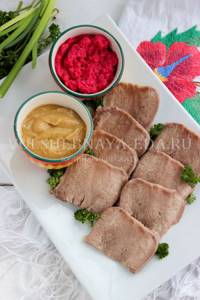
Beef tongue is a dietary product. It consists entirely of muscle tissue, does not contain cartilage and is easily absorbed. Pregnant women are recommended to use it due to the fact that it helps prevent anemia. People diagnosed with diabetes are advised to include this product in their diet because it improves insulin production. It is also useful for athletes, as it contains a lot of protein, and for elderly people, as it does not cause digestive problems, and for people recovering after surgery or a long illness, as it helps restore strength. However, not everyone cooks it often enough. Sometimes the absence of this valuable product on the menu is due only to the fact that the housewife does not know how to cook beef tongue. Cooking a cow's tongue is a lengthy process, but quite simple, so even an inexperienced cook can master this technology.
The benefits and harms of boiled beef tongue
The delicacy in question is included in the list of valuable by-products, and treats based on it are appreciated by even the most sophisticated gourmets. As you understand, beef tongue is a muscle in a shell, so harm occurs only due to health characteristics and individual intolerance.
Benefit
- There are no connective tissues, as a result of which it is well absorbed. Recommended for use by people with gastritis, anemia or stomach ulcers.
- Beef tongue improves insulin production, which makes life easier for people with diabetes. Insulin regulates glucose levels.
- Source of vitamins. Vitamin B improves the condition of skin and hair, vitamin PP helps fight insomnia.
- Beef tongue is especially useful for people after surgery and for pregnant women. It saturates the body with missing microelements.
The benefits of the product are due to the enviable content of useful elements - molybdenum, sulfur, chromium, phosphorus. Regular consumption improves the functioning of organs, helps the normal development of the body, stimulates the production of amino acids and hormones that have a positive effect on the nerves.
Features of cooking beef tongue so that it is soft and juicy
The technology for preparing any meat by-product has its own subtleties, and beef tongue is no exception. Knowing the peculiarities of its cooking and preparation for it, even a novice housewife can cope with the task.
- Try to choose the right beef tongue. Fresh will be juicier than frozen, salted will require long soaking. When choosing a fresh tongue, make sure that all excess material (lymph nodes, blood clots, sublingual connective tissue, larynx and hyoid bone) has been removed.
- If you purchased a frozen product, allow it to thaw gradually on the bottom shelf of the refrigerator or at room temperature, then it will lose a minimum of moisture.
- The salted tongue is soaked for 6 hours in ice water, changing to fresh water as it warms up.
- Before cooking, fresh tongue should also be soaked in cold water, but not for long, literally for half an hour. This will make the process of subsequent cleansing easier.
- Before you start cooking beef tongue, you need to rinse it under running water and clean it well, for this it is advisable to use a brush. If you need to shorten the cooking time or place a large tongue in the pressure cooker, you can cut it into several pieces.
- To make the tongue soft and juicy, it must be immersed in already boiling water. You can salt it no more than half an hour before it is ready. Some housewives do not salt the tongue at all during cooking, but do it after cleansing, dipping it in salted water and boiling for literally 15 minutes.
- It will be easy to clean the finished tongue if you transfer it from a hot liquid to ice water and leave it in it for 1-2 minutes. After this, you can remove the skin without difficulty.
- If you did not use the tongue immediately after cooking, store it in the broth, then it will remain juicy and soft.
Boiled tongue can be used for slicing meat or served with a side dish. The tongue is also used to prepare aspic, various salads and hot appetizers by baking it with vegetables or other products in the oven.
Cooking time for beef tongue
Beef tongue can weigh from 0.8 kg to 2.5 kg. The average weight of veal tongue is 0.4 kg. The cooking time of the offal depends on what it is cooked in, as well as on its size.
- In a saucepan, veal tongue (weighing up to 0.8 kg) is cooked for 2 hours, beef tongue weighing up to 1.5 kg is boiled for 3 hours. By-products heavier than 1.5 kg are boiled for 3.5-4 hours.
- The cooking time for tongue in a slow cooker is comparable to the time for cooking offal in a saucepan. It ranges from 2 to 4 hours depending on the size of the offal.
- In a pressure cooker, beef tongue will cook much faster. The average cooking time for this product is 45 minutes. The veal tongue will be ready in half an hour, but if the offal is large and belonged to an old animal, it is advisable to increase its cooking time to 1 hour.
The readiness of the tongue can be checked with a knife. If it enters the meat easily and clear liquid flows out of the product, it is ready. If the tongue is pierced with effort or a pinkish liquid flows out of it when pierced, you need to continue preparing it.
What are the benefits of beef tongue?
The usefulness of the product is explained by the abundance of valuable elements in the composition. Thus, B vitamins have a positive effect on the condition of hair and skin. Nicotinic acid helps with sleep disorders and headaches.
100 grams of offal contains almost half the daily requirement of zinc. This helps get rid of bad cholesterol, produce insulin and speed up recovery from wounds and injuries.
- anemic people;
- diabetics;
- those who suffer from cardiovascular diseases;
- pregnant and lactating women.
Boiled offal is useful for ulcer sufferers, as well as people with other diseases of the stomach and intestines. There is no connective tissue in such meat, which allows it to be easily digested without stagnation and putrefactive processes. Eating offal reduces the risk of intestinal cancer.
Due to its delicate texture and low amount of cholesterol (150 milligrams per 100 grams), the meat product is classified as dietary. Dishes based on it promote weight loss. Boiled beef tongue has only 173 kcal per 100 grams.
Asthmatics, allergy sufferers and people with thyroid problems should be wary of this food.
Beef tongue in a pan
- beef tongue – 1.5 kg;
- water – 3.5 l;
- carrots – 0.2 kg;
- onions – 100 g;
- laurel leaves – 3 pcs.;
- salt - to taste.
Cooking method:
- Rinse your tongue under running water and place it in a saucepan. Fill with cold water and leave to soak for 30-40 minutes.
- Wash the spices and leave them to dry.
- Remove the skin from the onion. Scrub the carrots and wash them. Cut the carrots into large pieces, leave the onions whole.
- Clean your tongue with a brush and rinse well again.
- Boil water and place the beef by-product in it. Cook for 10 minutes over medium heat, skimming off any foam that appears on the surface.
- Turn down the heat. Cover the pan with a lid. Cook the tongue for 2.5 hours.
- Place carrots, onions and spices in the pan with the tongue. Continue cooking it for half an hour.
- Check the readiness of the tongue by piercing it with a knife. When the offal is ready, transfer it to a container of ice water. After a couple of minutes, remove it from the water and clean it.
- Strain the broth, discarding the used vegetables and spices. Salt it. Boil it.
- Dip the cleaned tongue into the boiling broth. Boil it for 15 minutes.
After the specified time, the pan can be removed from the stove and the tongue can be used for its intended purpose.
How to cook beef tongue at home according to recipes from different countries
Original recipes from healthy offal can be found in cookbooks of different peoples of the world. They are considered traditional in Russia, China, Georgia, Brazil, Austria, France, Tunisia, and Poland. Let's try to cook some of them in our kitchen.
"Five Spice" from a Chinese Chef
Culinary virtuosos from China know how to perfectly cook boiled beef tongue. Thus, the famous chef Yang Chan Hu is sure that the most important thing is the balance of spices.
Ingredients:
- half a kilo of tongue;
- liter of chicken broth;
- large head of onion;
- three small spoons of granulated sugar and the same number of large spoons of soy sauce;
- a pinch of Sichuan pepper;
- cinnamon stick;
- six cloves;
- three anise stars;
- a two-centimeter piece of ginger root.
Cooking method:
- Boil the tongue for 8 minutes, put it in ice water and remove the skin.
- Chop the peeled ginger root into thin slices.
- Add spices and a whole peeled onion to the chicken broth. Heat to a boil and boil for 20 minutes.
- Add offal, soy sauce and sugar. Simmer on low flame for 60 minutes.
After turning off the stove, the tongue should cool in the broth and be saturated with the exquisite aroma of seasonings. Then it is removed and cut into thin slices. If you can't find Szechuan pepper, you can replace it with cumin.
How to cook a tongue in French: try “Langue de boeuf aux tomates”
The beautiful French name translates as “beef tongue in tomato.”
Ingredients:
- 2.5 kilograms of boiled tongue;
- onion;
- 40 grams of butter;
- garlic clove;
- a couple of pinches of dried basil;
- a pinch of black pepper and salt;
- five tomatoes (canned).
Cooking method:
- Fry finely chopped onion and garlic in melted butter.
- Add tomatoes cut into slices, spices, add salt.
- Heat to a boil and simmer covered over low heat for half an hour.
- Make the sauce by passing the contents of the pan through a sieve.
- Place the offal slices in a mold, pour in the sauce and place in an oven preheated to 190 degrees for 40 minutes.
To make the meat juicy, periodically open the oven and pour the sauce from the pan over the meat.
Cooking boiled beef tongue according to a recipe from Brazil
The piquancy and delicate taste of this dish is achieved by adding good red wine.
Ingredients:
- 1.5 kilograms of offal;
- a bunch of parsley;
- salt and black pepper;
- two cloves of garlic;
- onion head;
- 250 ml each of wine and soy sauce.
Cooking method:
- Cut the boiled tongue into slices 1.5 cm thick.
- Filter the broth.
- Chop the onion and garlic cloves and fry in a hot frying pan.
- Add meat slices to them, add salt, pour in 250 ml of broth and simmer on low flame under the lid for half an hour.
- Add wine, spices, chopped herbs and heat to a boil.
The Brazilian dish goes best with boiled rice.
Properly prepared tongue is healthier than store-bought delicacies. It is suitable for the diet of adults and children and harmonizes perfectly with most side dishes.
For example, my mother always cooked tongue without salt. She explained this to me by saying that otherwise it would be impossible to remove the membrane from the finished tongue. I cooked this way for many years until I saw a recipe in a serious cookbook. It turned out that salt has nothing to do with removing the shell - the shell can be easily removed from a tongue boiled with salt!
So it turned out that this simple matter has many nuances and there is material for thought!
So, you went to the market or store and want to buy a language.
Which one to choose: beef, veal, pork or lamb, fresh or frozen?
When choosing a language, you need to remember: the tongue belongs to the category of internal organs, i.e. to offal, therefore, like other offal (for example, kidneys) it has a specific taste and smell, which depend on the age of the animal: the younger the animal, the less pronounced the smell and taste will be. This especially applies to beef. If you like a mild taste, look for veal tongues, focusing not on the words of the seller, but on the size and weight. The weight of veal tongue usually does not exceed 1 kg - 1 kg 200 g. In any case, the smaller the tongue, the tastier and more tender it will be.
Spots on the coat of the tongue have no effect on the taste of the tongue and are associated with the breed of livestock and nothing else.
Whether the tongue is fresh or frozen doesn't really matter, the main thing is that the tongue is frozen only once and not multiple times. Thaw the tongue in the refrigerator, slowly, so it does not lose much liquid during defrosting.
See how ready the tongue is for cooking.
This means that everything unnecessary has been cut off from it: muscles adjacent to the root of the tongue, cartilage and small bones, salivary glands, lateral parts of the membrane in which there is no meat, external fat.
If the tongue is not processed and cleaned (most often it is sold this way on the market), do all this work yourself.
Rinse your tongue thoroughly under running water and now decide what you will do with it.
Actually, you have two options - boil the tongue immediately or pre-soak it in salt and (if desired) in spices.
Which option should I choose? I always prefer not to season my tongue with spices and garlic because I love the clean taste of it.
However, your choice may be different, and you will want to salt your tongue.
Boiling the tongue without first salting it.
1. Place the tongue in a saucepan, add water so that it completely covers the tongue and bring the water to a boil. Cook the tongue for 10 - 15 minutes.
Pour the water out of the pan, rinse the tongue with clean water, return it to the pan and pour boiling water over it so that the entire tongue is covered with water. This simple operation will make it possible to use the broth later to prepare soup.
If you plan to discard the broth in any case, you don’t have to change the water. Conversely, if the smell of the broth in the first five minutes seems too strong and unpleasant to you, cook the tongue longer - 30 minutes, and then change the water.
2. Bring the water to a boil again. Add 2 tsp. salt (without a slide!), spices to taste. I usually add: 2 allspice (English) peppercorns, 5-6 black peppercorns, 1 tsp. Coriander grains are an aromatic plant of the Umbelliferae family. Young shoots of coriander are called cilantro. Dried leaves and seeds are used as spices. Coriander has been known as a spice for more than 3 thousand years and is considered one of the most common and versatile spices. The fruits of coriander (cilantro) look like small grains of light brown color, round or elongated. Used whole or in ground form as a spice for flavoring and fortifying sausages, cheese, canned meat and fish, marinades, pickles and liqueurs... .
3. Cook the tongue over very low heat until tender. Boiling time for veal tongue: 2-2.5 hours, beef tongue: 3-3.5 hours. If desired, you can add carrots and onions, as when cooking regular meat.
If you have a pressure cooker, you can boil the tongue in it. Cook for 30 minutes, then open the pressure cooker and check for doneness. If necessary, finish cooking the tongue.
The language has a heterogeneous structure. At the root, the muscle has a large diameter, is relatively loose and is completely riddled with fat; the tip of the tongue has a small diameter, is not at all fatty and is more dense. That is why the readiness of the tongue is always checked by the tip.
Usually it is advised to pierce the tongue and focus on the ease of insertion of the blade. I don't recommend doing this. Cut off the tip of your tongue and chew - this way you will get the most objective information about the degree of readiness.
If you serve the tongue as a cold appetizer, take into account that the cooled tongue will become denser and tougher, so it should be cooked a little more than you currently think is normal.
If, on the contrary, you additionally simmer the tongue in the sauce, do not cook it until fully cooked. As soon as you see that the membrane at the thin end of the tongue has swollen and began to lag behind the meat, you can consider the tongue ready.
In any case, do not overcook the tongue, otherwise it will become loose and stringy.
4. Pour cold water over your tongue and remove the membrane. Start at the tip of your tongue, where it is thicker and easier to separate. At the root of the tongue, the membrane is thin and sometimes comes off with great difficulty - cut it off with a thin knife.
You can leave the tongue in the broth until completely cooled before removing the skin if you are serving it with sauce.
If you serve the tongue without sauce, I would advise removing the skin from the hot tongue. If you season a hot broth with spices or garlic, put a cleaned tongue in it and let it cool along with the broth, the tongue will absorb the aromas and taste of the seasonings.
5. Store the tongue in the broth until serving, or wrap the tongue tightly in cling film and store there.
6. Place the tongue in the refrigerator and let it cool completely. You can cut cold tongue into beautiful and thin slices.
Second option: boiling the tongue with preliminary salting.
If you kept your tongue in brine or dry salt for less than 5 days, then in principle you can cook it the same way as tongue without salting, just without adding salt to the water.
If you kept your tongue in salt or brine for more than 5 days, you will have to pre-soak it to remove excess salt, and only then boil it.
You can read about how and how long to soak your tongue in the article on salting the tongue.
How and with what to serve ready-boiled tongue.
1. Slices of tongue are fried in butter, sprinkled with coarse salt and served with gherkins.
2. Cold tongue slices served with horseradish or mustard.
3. Aspic is prepared from the tongue. For example, in the form of portioned snacks as in the recipe
4. The tongue can be served with a cold sauce, such as mushroom sauce.
5. There are many options for preparing tongue in hot sauce: mushroom, tomato, wine, etc.
The culinary industry offers a large number of delicacies that can satisfy the gastronomic needs of any person. These include boiled beef tongue, which is easy to chew and incredibly tasty. The article on how to cook beef tongue will reveal the secret of preparing this delicacy.
Boiled beef tongue is served as a separate treat and added to appetizers and cold dishes. It is found in salads and is used to make delicious sandwiches. It is not surprising that it is considered a universal product.
Preparing boiled beef tongue is simple, but time consuming. Rush is inappropriate, otherwise the dish will turn out to be extremely tough. The cooking time is determined by the age of the animal whose tongue you decide to eat.
Beef tongue in a slow cooker
- beef tongue – 1 kg;
- water – 2 l;
- carrots – 100 g;
- onion – 100 g;
- garlic – 2 cloves;
- peppercorns, laurel leaves, salt - to taste.
Cooking method:
- Place the prepared beef tongue in the multicooker bowl.
- Peel the onions, garlic and carrots. Cut the carrots into large pieces, cut the onion in half, leave the garlic cloves whole.
- Place the prepared vegetables on your tongue.
- Fill the food with water.
- Turn on the device by selecting the “Extinguishing” program. Set the timer for 3 hours.
- When the program finishes, add salt and spices. Start the unit again in extinguishing mode, but for half an hour.
- Place your tongue in cold water and leave for a couple of minutes.
All that remains is to clean the tongue, cut and serve. There is no need to throw out the broth in which it was cooked: it is suitable for jellied meat, and if you dilute it, you can cook soup with it.
Beef tongue in a pressure cooker
- beef tongue – 1.5 kg;
- onions – 100 g;
- carrots – 100 g;
- salt – 10-15 g;
- dried herbs – 5 g;
- water - how much will go in.
Cooking method:
- Wash and clean your tongue. Rub it with salt and dried herbs. Place in pressure cooker container. If it doesn't fit, you can cut it in half.
- Peel the vegetables and cut them lengthwise into quarters. Place pieces of vegetables near your tongue.
- Fill the food with water until it completely covers it.
- Close the pressure cooker and run it for 45 minutes.
- After the specified time, release the steam and wait for the pressure to normalize.
After this, you can carefully remove the tongue, immerse it in cold water and clean it. If your tongue is larger than indicated in the recipe, it is advisable to increase the cooking time to an hour.
Beef tongue for aspic
- beef tongue – 1.5 kg;
- onions – 100 g;
- carrots – 100 g;
- celery or parsley root – 100 g;
- black peppercorns – 5 pcs.;
- allspice peas – 5 pcs.;
- cloves – 3 pcs.;
- bay leaf – 2 pcs.;
- salt - to taste;
- water – 3 l.
Cooking method:
- Dip the washed and cleaned tongue into boiling water.
- When the water in the pan boils again, cook the offal meat for 15 minutes over medium heat, skimming off any foam that appears on the surface.
- Reduce heat, cover the pan with a lid, leaving a gap, and continue cooking the tongue for 3 hours.
- Peel the onion, cut in half.
- Peel the carrots and celery root. Cut them into large pieces of arbitrary shape.
- Place the roots in the pan where the tongue is cooked. Put the spices there too.
- When the water in the pan boils again, add salt to the broth to taste. Continue cooking the tongue for another half hour.
- Place your tongue in cold water. After a few minutes, remove it from the water, dry it and clean it.
The broth in which the tongue was boiled is also used to prepare aspic, having first filtered it. Vegetables and spices are discarded from the broth. If the aspic contains carrots, they are boiled separately.
Beef tongue for salad
- beef tongue – 1.5 kg;
- allspice peas – 3 pcs.;
- bay leaf – 2 pcs.;
- salt - to taste;
- water – 3 l.
Cooking method:
- Boil water and dip the prepared tongue into it.
- After cooking it for 10 minutes over medium heat, skimming off the foam, reduce the intensity of the flame. Continue cooking the tongue until done. This will take about 3 hours.
- Dip your tongue in cold water to clean it.
- Strain the broth and add salt to taste, add spices to it.
- Place the cleaned tongue in the broth and cook for 15 minutes.
When preparing tongue for salad, you should not add a lot of spices and aromatic roots to the broth, so that the smell of the main ingredient does not interrupt the aroma of the other components; because of this, the appetizer may acquire an inharmonious taste.
Beef tongue is healthy and tasty on its own if it is properly boiled. You can cook this product in a saucepan, slow cooker, or pressure cooker. When cooking it for aspic, roots and spices are added to the broth. When preparing a product for salad, spices are added in minimal quantities so that its smell does not prevail over the aroma of other components of the appetizer.
